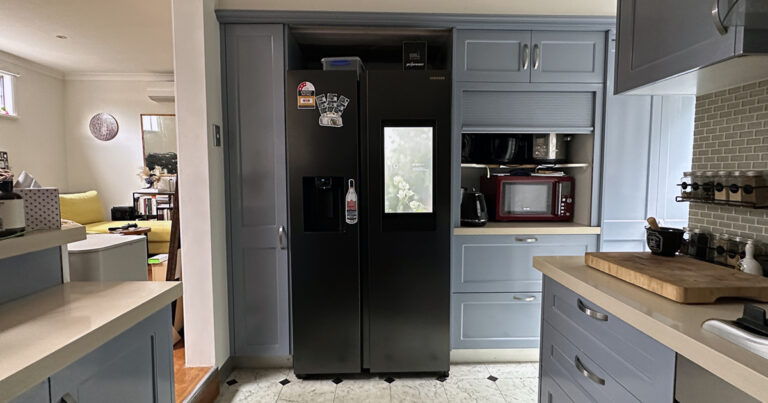So audacious, so Samsung.
Samsung Family Hub Smart Refrigerator (6th generation) review: I love it, but I have notes
It's hard not to love the idea of a big ass touchscreen on a fridge. I find the concept so audacious, so Samsung, that it skips past extravagant and goes straight to endearing. Admittedly, I am the exact demographic for the Samsung Family Hub. I'm an avid home chef, and a massive geek. I'm right in the middle of the marketing Venn diagram.
Despite being a big fan of companies putting tech where it doesn't belong, my big question with the Family Hub is whether the smart functionality makes it worth the premium over a dumber model. The 6th generation Family Hub fridge I tested - the SRS656MBFH4 - retails for $3,449 (although can be found for around $3,096 at time of writing). The comparable touchscreen-less model will set you back $2,529. You're paying a $920 premium to buy a fridge from the future.
Samsung Family Hub as a fridge
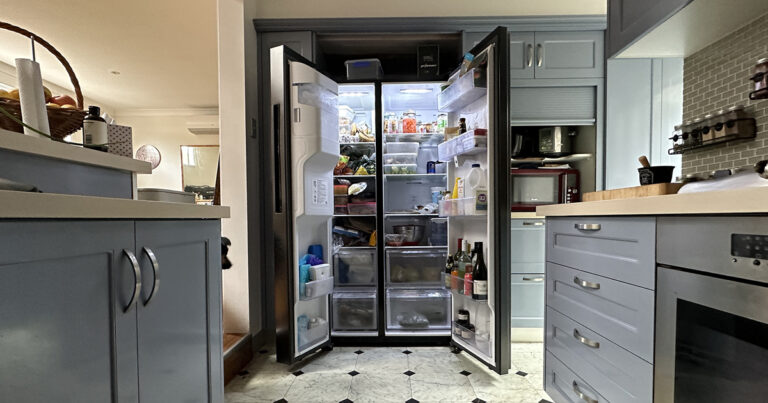
Let's get this out of the way first, the Family Hub is an excellent fridge. It's spacious, well organised, and cold.
The fridge section has four shelves and two crispers, as well as five compartments in the door. Two of these compartments are tall enough to hold a wine bottle, while the other three are a bit shorter - especially the top compartment. There's also a non-plumbed water and ice dispenser, with the 4.5L reservoir taking up a small chunk of space in the fridge. The only real layout quirk is that you can't have both crispers open at once, and you need to open the door pretty wide to be able to pull the drawer all the way out.
It's a similar situation on the freezer side. You get four shelves and two crispers, but only two in-door compartments. One of these is absolutely tiny. The freezer is also a bit narrower than the fridge section.
I'm a big fan of the power cool and power freeze features. When switched on, power cool can chill a room-temperature bottle of wine within 15 minutes. Power freeze gets a hot shot of coffee to the right temperature for an espresso martini in ten.
Naturally, you use the touchscreen to turn these on. And in a way, it makes a lot of sense, as we're used to using touchscreens for most of our tech. You can also ask Bixby, which works well enough for the most part.
How smart is the Samsung Family Hub?
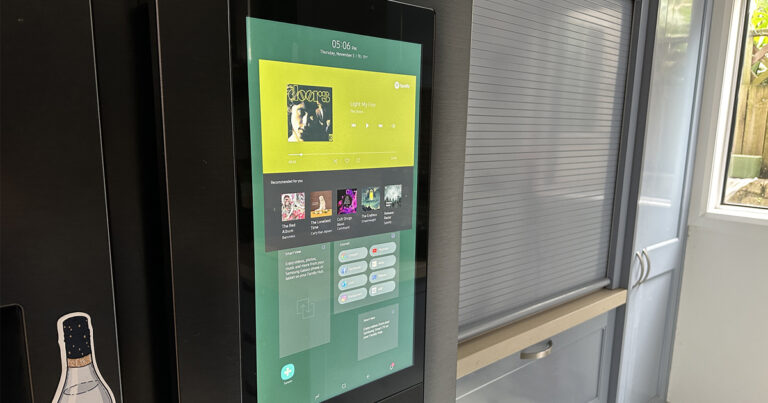
The Samsung Family Hub's software looks a lot like Android, but runs Samsung's proprietary operating system, Tizen. Tizen is fine for the most part, but is a limitation for what you can use the 21.5-inch screen for.
By and large, you're stuck with the preinstalled apps, which tend to be first-party Samsung products. You get the basics like a calendar, a photo gallery, a web browser, a timer, a weather app, and a to-do list.
These all work well enough, but tend to be barebones. The gallery app, for example, lets you put photos on your home screen. These can only be stationary though, rather than making a slide show as you can on smart displays like the Google Nest Hub. I do like the way that photos have a bit of wiggle to them as you swipe through your home screens.
If you prefer to talk to your tech, you can ask Bixby to do things for you, and a recent update added Alexa. Alexa can't control fridge functions, like power freeze, however.
There are a couple of third-party apps you get out of the box, like minimalistic takes on Spotify and Ring. The Spotify app is so basic that you can't even search - you can only play things you've recently been listening to. It's fine, but it could be so much more. The Ring app gives you barebones functionality for checking your cameras, but not much else. It does however mean your fridge rings when someone rings your doorbell, which might save you some money on an extra Ring Chime.
You can also use the web browser in some cases, where the Family Hub doesn't have an app. This isn't a surefire solution, however. YouTube works well enough in browser for example, but Netflix doesn't run.
I can't help but wish Samsung shipped the fridge with Android. Let me use whatever calendar app or streaming service I want. Let me install the actual Spotify, rather than the stripped-down version you get. Let me play Bejewelled on my fridge, because why not?
If you want to avoid the Spotify app on the fridge - or use a different streaming service - the Family Hub lets you connect to it as a Bluetooth speaker. Firstly, it's very funny thinking of your fridge as a Bluetooth speaker. Secondly, it's a surprisingly good Bluetooth speaker.
You get clear, balanced audio that does justice to the more challenging songs on our Audio Testing playlist, like Opeth's "The Funeral Portrait". Bass can be a little recessed but is still present in the mix. Unsurprisingly, the Family Hub speaker barely handles sub-bass. You don't quite get a muted thud, but you get very little impact from ultra-low frequencies.
The Family Hub also lacks any discernible stereo separation when you're not right in front of the fridge. You can tell there's a left and right channel if you get up close and put on a track like "Light My Fire" by The Doors where instruments have a hard pan, but that's not exactly how you listen to music in the kitchen.
Otherwise, the Family Hub sounds pretty great. It's not audiophile quality, but I didn't expect to a fridge to make this good a speaker.
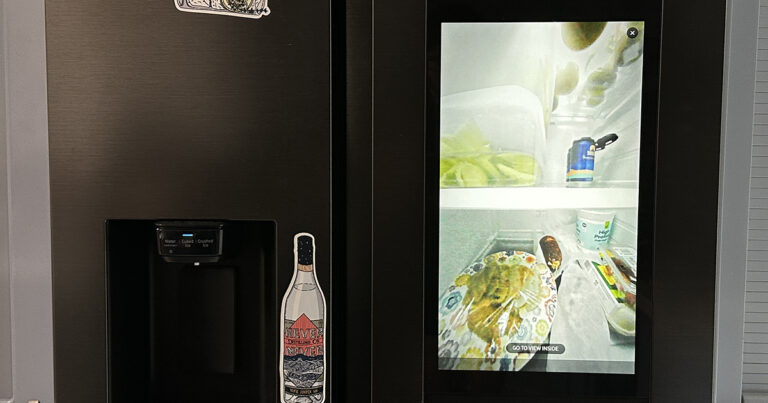
Samsung naturally pitches a few Family Hub use cases that are more food-centric. The big one is being able to see inside your fridge remotely. This sounds great in theory, but the execution is awful. The internal camera is not good - it's far too low a resolution, nothing like what you see in the marketing photos. That can be forgiven, but the main issue is you can only see a very small portion of what's in the fridge (as pictured above).
If you were going to truly take advantage of the camera, you'd need to organise your Family Hub around its field of view. And honestly, that probably wouldn't be the best way to keep your produce.
You can access the Family Hub camera remotely through the Samsung SmartThing app. This works well enough on Android, but the iPhone app takes far too long to connect.
A key selling point is logging what you've got in the fridge, but in practice, this ends up being far too much of a chore. You need to add items and their expiry dates manually, which is the last thing I want to do when I'm putting groceries after a bit shop. Surely there'd be a more high tech way to implement this, like scanning barcodes or using a combination of cameras, sensors, and AI in the same way the checkouts at Woolies can work out what fruit and vege you're weighing.
Lastly there's a meal planner app that lives on one of the Family Hub's home screens. While I've not taken full advantage of it because of how long it takes to log food, even the standard feed has given me a bit of inspiration.
Is the Samsung Family Hub worth buying?
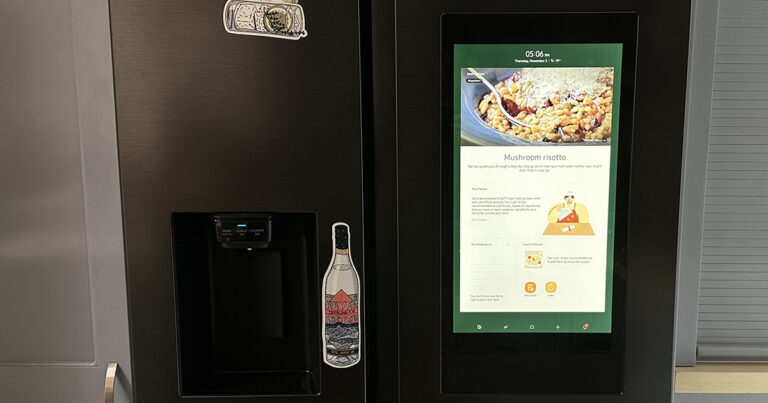
I love idea of the Family Hub, but it has a lot of potential that it doesn't quite reach. Firstly, it's an amazing fridge! On the smart side, the speakers are great, it does a number of basics well, but it could do so much more. Even simply swapping out Tizen for Android as the operating would solve a lot of limitations I've run into, and make the Family Hub more versatile.
Smart displays already make a lot of sense in the kitchen, and the Family Hub is an extension of that idea. There's also the benefit of utilising existing space rather than taking up room on a kitchen bench.
The counterargument is fridges are the kinds of devices that last over ten years, while most tech products don't. If your smart display carks it after a few years, it's not the end of the world. It's a $200 product. Not great, but sadly par for the course these days.
But if the smart display component of your fridge starts giving you problems a few years down the line, what's your recourse? While you could still definitely keep using your fridge without the smart functionality, you'd lose the ability to adjust temperature and turn on power freeze and power chill.
There's also the question of software life. Samsung no longer offers software updates for the 1st generation Family Hub, which was released in 2016. Only models released 2017 onward are currently getting new features. A 2016 fridge may be old in tech terms, but is still quite young for an appliance. A Samsung spokesperson told me the company doesn't have an official policy, but provides software support on all recent Family Hub models "in line with best practice for the market".
This makes the purchasing decision even harder. Combining an appliance that should last over a decade with tech with an uncertain lifespan is a recipe for problems down the line. Samsung needs clear policies around security updates for its fridges that cover at least a decade. Until then, my heart wants the fridge with the big ass touchscreen, my brain can't help but be concerned about the ramifications - especially when you're paying a $920 premium.
Related Articles



